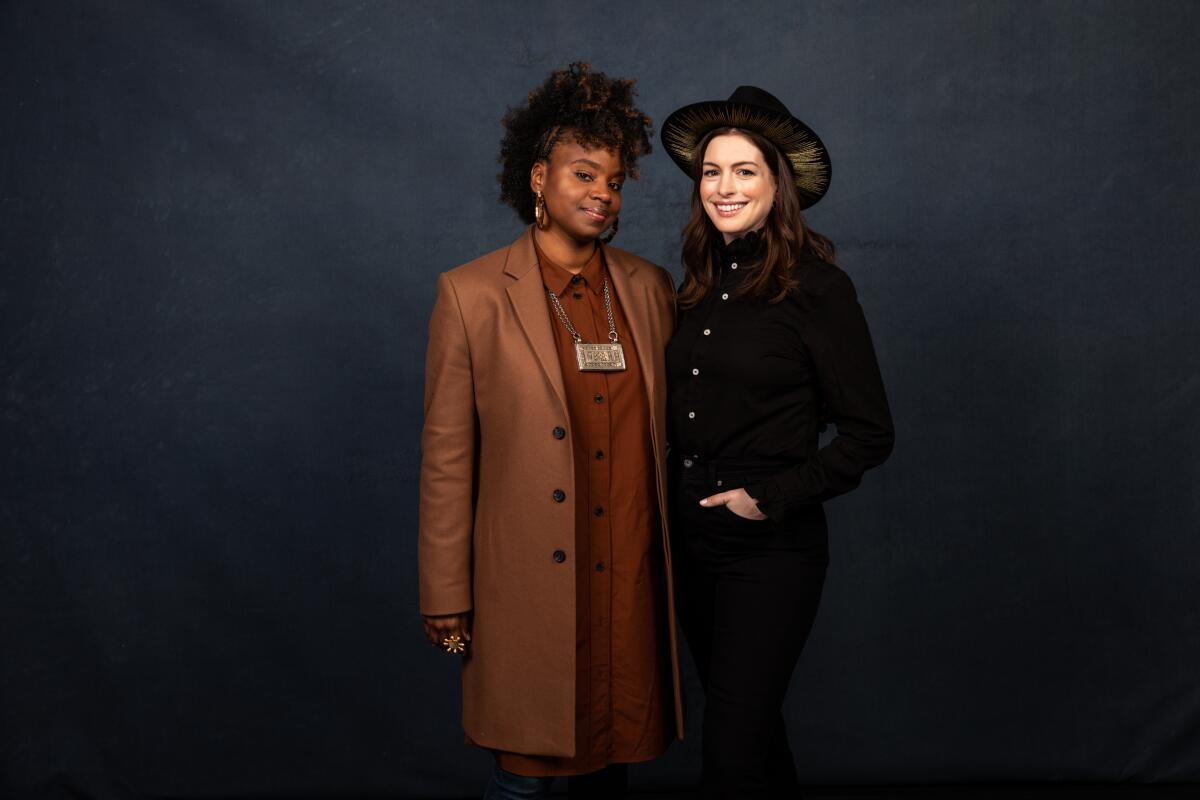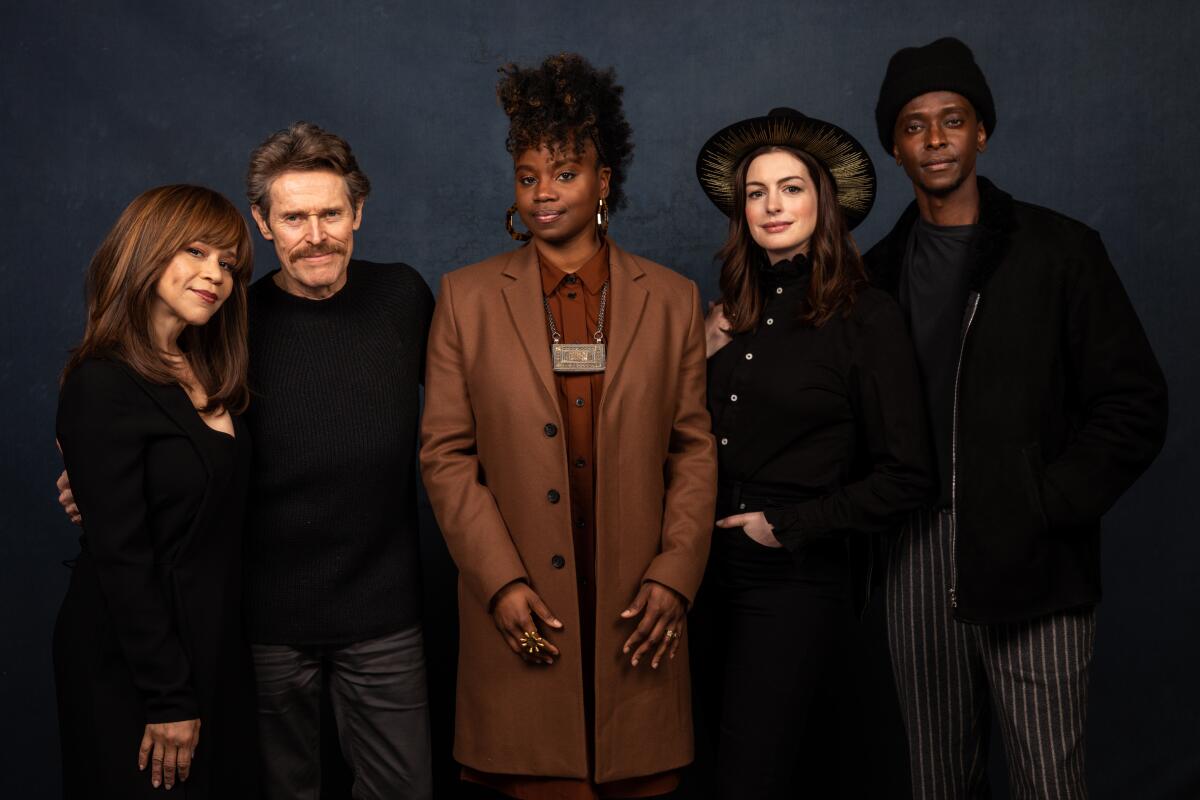How Anne Hathaway and Dee Rees made Netflix’s ‘The Last Thing He Wanted’ on their own terms

- Share via
A 1970s-style paranoia thriller set amid the American interventionism of the 1980s made by one of the most exciting filmmakers of right now, “The Last Thing He Wanted” is a movie that refuses to behave as it should.
Directed and co-written by Dee Rees, the movie is an adaptation of Joan Didion’s 1996 novel of the same name. The story is a swirl of shifting allegiances, agendas and motivations as Anne Hathaway stars as American newspaper reporter Elena McMahon swept up in a story she can’t see her way out of.
In the film, having been pulled away from her work regarding U.S. involvement in Central American revolutions, McMahon walks off an unwanted assignment covering the 1984 presidential campaign. Trying to help her ailing father (Willem Dafoe), she gets ensnared in a gun-running scheme that draws her back to Central America. She falls deeper into a downward spiral as she is pulled between a U.S. government official named Treat Morrison (Ben Affleck) and an operative of uncertain affiliation known simply as Jones (Edi Gathegi).
Though the film takes its liberties with Didion’s book — inventing a fellow journalist played by Rosie Perez, ramping up the supporting character of Jones — Rees has her own feelings as to whether it is a faithful adaptation.
“It depends what you mean by faithful. I feel like to her cadence and to her language and to the milieu, I think it is faithful to Didion’s worldview,” Rees said in an interview alongside Hathaway in Park City, Utah, a few hours before the film’s January premiere at the Sundance Film Festival.
Rees first broke out at the 2011 Sundance Film Festival with her debut feature “Pariah,” which was picked up by Focus Features and went on to win Gotham and Spirit Awards and the NAACP Image Award for outstanding independent motion picture. After making the television film “Bessie,” she was back at Sundance in 2017 with “Mudbound,” which was picked up by Netflix and went on to earn four Oscar nominations.
All of which made it more startling when “The Last Thing He Wanted” premiered at Sundance to a calamitously dismissive reception. Yet since the film launched on Netflix on Feb. 21 it has been ensconced in the top of the platform’s new daily rankings.
And where one poorly received film might once have derailed the career of a woman-of-color filmmaker like Rees, she already has plenty more projects lined up. A recent New York Times Magazine profile rattled off multiple possibilities, including an ambitious futuristic saga. It was also announced earlier this month that she is attached to adapt George Gershwin’s musical “Porgy and Bess.”
With “The Last Thing He Wanted,” Rees attempts to capture the feel of Didion’s prose in the camera work, working with cinematographer Bobby Bukowski, often with a breathless abandon. In an early scene in the movie, as Hathaway and Perez are running to make a plane that will safely get them out of a war-torn hot spot, the camera breaks away from the two of them to hurtle through a terminal, past a luggage check-in, out a doorway and onto an expanse of tarmac only to catch back up to the pair as they scramble aboard a waiting plane. There is isolation and uncertainty in nearly every frame of the movie.
Among the biggest alterations by Rees and her co-writer Marco Villalobos from the novel is ramping up the character of Jones, who repeatedly shows up to save Elena even as she refuses to trust him. That Jones is black and yet Elena instinctively trusts the white U.S. official she nevertheless knows to be dubious — the casting of Affleck and all the baggage he brings is particularly sharp — brings an awareness of race and perspective to the story that is not present in Didion’s novel.
“I just wanted to add that to make it more complicated and make it more interesting,” said Rees. “So it’s not just to show how internal she is. That conceptualizes her and helps you understand why this woman thinks that she’s a step ahead. So all that gives us context. I needed you to question the idea of heroism, in the big scale we’re looking at American imperialism and then Treat in micro is kind of a personification of that idea, in that he is the system.”
For Hathaway, even with all of the uncertainties and ambiguities of the story, there were a few things she was sure of.
“It was the most clearly drawn character I’ve ever gotten to play,” said Hathaway, “which is ironic because she spends the entire film in a fog.”
It was the most clearly drawn character I’ve ever gotten to play, which is ironic because she spends the entire film in a fog.
— Anne Hathaway on her character Elena McMahon in ‘The Last Thing He Wanted’
Hathaway first became acquainted with Didion’s writing when director David Frankel gave her some of the author’s work before shooting “The Devil Wears Prada.” The often crisp terseness of Didion’s prose was something that Hathaway latched onto.
“There’s something about her that she knows exactly how to describe in as few words as possible what you need to hear to take in what you’re listening to. Seriously, it’s a gift,” said Hathaway. “And that was the thing for me.”
As to whether Hathaway’s performance was intended to somehow embody Didion, famous for her low-key bicoastal glamour, rail-thin with cigarettes and sunglasses, the actress first deferred to her director.
“I wanted to almost invert Anne,” said Rees. “So sunburn the skin and lighten the hair and she was game for that. There’s this one photo of Didion smoking a cigarette and that’s one photo I wanted the costume designer to have and Anne had. There’s like a such attitude in it, but I think Anne found her own character.”
Spoiler alert: How the ending of Netflix’s “The Last Thing He Wanted” reflects the film’s political and social messages.
As Hathaway recalled, “My agent called me and said, ‘Dee wants to talk to you about a weight transformation.’ In my mind I’m like, ‘Oh, it’s Joan Didion, she wants me to lose 20 pounds.’ And then Dee said, ‘I need you to gain 20.’”
“You didn’t even look like you gained 20, you gained like 2,” interjected Rees.
“We’ve had this discussion. I gained the weight,” Hathaway coolly continued. “I gained the weight because I had to lose the weight. So anyway, when Dee asked me to do that I thought, ‘That’s so interesting, because you’d think me playing Didion, you’d want to go towards Didion.’ And then I said, ‘Why do you want me to gain the weight?’ totally game, and she said, ‘Because I want you to look like someone who can handle herself.’
“And then I remembered a line from the Joan Didion Netflix documentary in which Joan talks about how conflict-averse she was,” Hathaway said. “She doesn’t think she’s ever had conflict, a confrontation, in her life and she saves all of her confrontation for her novels. And I thought, ‘Oh my gosh, what if I took Dee’s instinct and I was that Joan Didion who could handle herself and I ran towards conflict?’ And that opened the character up for me in this big way, someone who had tried to play the game and the game didn’t work out and she was just so angry. She made a decision to not play that game anymore no matter what.”

Even speaking before the film’s premiere, Hathaway was well aware that there would be some people who would see her as wrong for the role, that the sweetness that is so often part of her persona both on screen and off can be an impediment to what people think she is capable of.
“I knew I had this character inside of me and, opening up a little bit, the sweetness thing is something that stood between me and getting parts in the past,” Hathaway said, “where directors meet me and they don’t see the part, they just see this Labrador puppy coming at them. And I just had this moment where I was just like: ‘If not now, when? I need to show who this person is, I need to show what I have.’
“Here’s the thing, I’m dealing with this thing where I want to tell stories like this and people don’t always see me in this way,” Hathaway said, “but I’m a 37-year-old woman. I’ve lived a life. Of course I have desperation to me. Of course I have anger to me. Of course I have frustration and of course I’ve made mistakes. I was just really grateful that I was working with an artist who understood that the person you are doesn’t necessarily always reflect entirely what you can do. I really appreciated that.”
Rees noted that appreciation went both ways right from their first meeting at L.A.’s Chateau Marmont, adding that she too can still feel as if people do not take her seriously enough even after making three films and earning an Oscar nomination.
“The fact that you, Oscar-winning, talented actress were taking me seriously, saying let’s sit down at the Chateau and talk about this and here’s how I know this character, I was impressed,” said Rees. “You wanted the character and you believed in me. You saw it in me like I trust you to do this.”
More to Read
Only good movies
Get the Indie Focus newsletter, Mark Olsen's weekly guide to the world of cinema.
You may occasionally receive promotional content from the Los Angeles Times.











